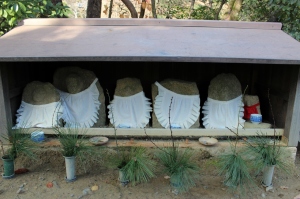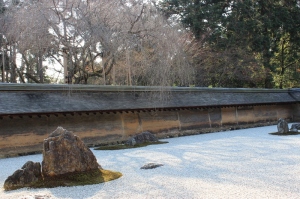After visiting Kin-Kaku-ji, we took a bus to Ryoan-ji temple. The Kyoyochi Pond is another admirable pond in Kyoto. It is lined with Persimmon trees. The pond looked great even in the winter. I couldn’t imagine how beautiful it would be in spring.
There is a small island in the pond which is called the “Benten Island”. The brochure said there are seven deities and one of them is the “Goddess Sarasvati”. I was quite impressed and was very eager to see how the Goddess Sarasvati is depicted in Japan. Goddess Sarasvati is widely worshipped in India. In Hinduism, Sarasvati is the Goddess of Knowledge, Music, Arts and Science.
We were able to see a small temple but couldn’t see any Goddess inside. Near the temple were six stone carved idols. Both of us couldn’t recognize Goddess Sarasvati. We looked up and down in the island searching for Sarasvati and proceeded to the main building.
After returning from Kyoto, I googled to get some information about the Goddess Sarasvati in Ryoan-ji. I found out that “Benten island” is named after her. Benten is the short form of “Benzaiten”. Benzaiten is the Japanese name for the Hindu Goddess Sarasvati. Worship of Sarasvati/Benzaiten arrived in Japan during the 6th-8th century, mainly via the Chinese translations of “Sutra of Golden light”. This sutra was originally written in India in Sanskrit in the name of “Suvarnaprabhasa-sutra”. It was translated to Chinese and later translated to many other languages. Back in India, Sarasvati holds a Veena while in Japan she holds a Biwa, a traditional Japanese lute.
The article specified that our wishes will come true if we place a stone on the torii (gate found at the entrance of the temple). I then zoomed our photos of the torii and found stones placed on it. We dint know about it when we were there 😦
We reached the Rock garden. It was nothing like what I imagined. It consists of white gravel and 15 rocks. It is rectangular, has no trees and surrounded by low earthen walls. The walls were made of clay boiled in oil. The brochure says it’s up to each visitor to find out what this garden signifies. The longer we look at it, the more varied our imagination becomes. This must be interesting to people who meditate.
All I could see/imagine was on the earthen walls. I felt like there was a man walking at sunset. He looked like he wore pants with his hands in the pockets. 😛 I know… I know… It was centuries before and its Japan…





